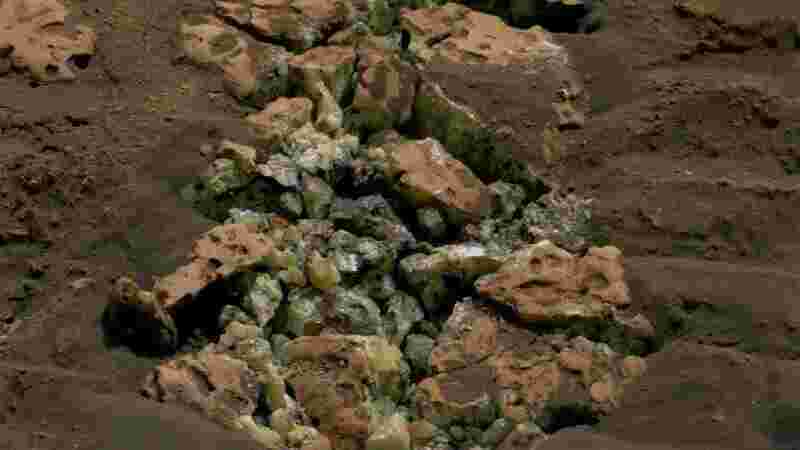The Curiosity rover has made a remarkable discovery on Mars: rocks composed entirely of pure sulfur. This unusual find happened when the 1-ton rover inadvertently drove over a rock, cracking it open to reveal never-before-seen yellowish-green crystals on the red planet. "This is, without a doubt, the strangest and most unexpected finding of the entire mission," remarked Ashwin Vasavada, Curiosity's project scientist at NASA’s Jet Propulsion Laboratory in Pasadena, California. "It’s all about luck; not every rock yields interesting surprises."
The Curiosity team was excited to explore the Gediz Vallis channel, a meandering formation that appears to have been created 3 billion years ago by flowing water and debris. This channel winds through part of Mount Sharp, which rises 3 miles (5 kilometers) tall. Since 2014, the rover has been steadily climbing this mountain. Having spotted white stones in the distance, scientists wanted to take a closer look. Rover operators at JPL executed a 90-degree turn to position Curiosity for capturing a mosaic image of the surrounding terrain. On the morning of May 30, Vasavada and his team examined Curiosity’s mosaic and discovered a crushed rock within the rover's tire tracks. A detailed examination of the rock revealed the "mind-blowing" discovery, according to Vasavada.
Curiosity's past findings, including evidence of ancient lakes and organic materials, have contributed to its main goal: to establish whether Mars ever harbored habitable environments. Now, scientists are focused on deciphering the significance of pure sulfur on Mars and its implications for the planet’s geological history.
Previously, Curiosity had identified sulfates—salts containing sulfur formed from evaporated water—on Mars. The team has also found calcium sulfate, or gypsum, within surface cracks, indicating deposits left behind by ancient groundwater. "Pure sulfur was something no one anticipated," Vasavada acknowledged. While sulfur rocks generally exhibit a stunning translucent crystalline texture, Mars's weathering processes have eroded the outer surfaces, causing them to blend with the predominant orange hues of the planet.
The team was astonished when they first glimpsed the "gorgeous texture and color" within the rock, and their analysis using Curiosity’s instruments confirmed it was pure sulfur. A historic comparison comes from NASA's Spirit rover, which once dragged a broken wheel and uncovered bright white soil that turned out to be nearly pure silica—an indication that ancient hot springs or steam vents may have existed on Mars, potentially conducive to microbial life. This silica discovery, made between 2004 and 2011, was pivotal; it inspired the Curiosity team to explore rocks more thoroughly, leading to the significant sulfur find.
Briony Horgan, a co-investigator on the Perseverance rover mission and professor of planetary science at Purdue University, expressed her amazement: "The discovery of pure elemental sulfur is very unusual, as we mainly find it in environments like hydrothermal vents on Earth—think Yellowstone. This raises intriguing questions about the formation of sulfur-rich rocks in Mt. Sharp."
While exploring the Gediz Vallis channel, Curiosity transmitted images of a flat expanse approximately half the size of a football field, dotted with striking white rocks. Initially misidentified as debris from the channel, the team later theorized that these "strange rocks" formed at their current location. While they wanted to sample these rocks, Curiosity was unable to drill into them due to their small and fragile nature. Instead, the team examined a nearby large rock, dubbed "Mammoth Lakes." Analysis of its dust, conducted by the rover's onboard instruments, revealed a diverse array of minerals, unlike anything previously encountered in the mission.
Since landing on Mars on August 5, 2012, Curiosity has ascended 2,600 feet (800 meters) up Mount Sharp from Gale Crater's floor, which was once an expansive, dry lake bed. Each layer of the mountain reveals different aspects of Mars's history, from wet epochs to drier phases. Curiosity is currently investigating various geological features, including the Gediz Vallis channel, which formed later than the mountain itself by cutting through its layers. The channel’s formation was influenced by both violent water flows and landslides, as observed by the rounded and angular shapes of the rocks.
"This was a time of significant activity on Mars," noted Becky Williams, a scientist at the Planetary Science Institute. "We’re scrutinizing multiple flow events, which include energetic floods and debris-laden flows." Scientists are eager to understand how much water was actually present when the channel was carved.
The Gediz Vallis channel has intrigued scientists, including Vasavada, for years. "I remember studying orbital images of it long before Curiosity landed," he reflected. "Seeing the rover finally reach the channel was a surreal moment."
Though the precise origins of the sulfur remain a mystery, the research team continues to analyze data gathered by Curiosity to unravel the geological history represented in the minerals. “It’s possible this rock has experienced various environmental conditions, which intersect in complex ways—we need to piece it all together,” Vasavada explained.
Curiosity remains committed to exploring the channel in search of further surprises. Afterward, it plans to move westward along the mountain to investigate more intriguing geological features. Despite 12 years of operation, which included several "close calls" with mechanical issues, Curiosity is still in excellent condition, maintaining a sense of gratitude for its ongoing exploratory and scientific journey. "I feel fortunate, but we're also cautious, knowing that we might face future challenges. However, we're grateful for the wealth of discoveries we've had here over the years," Vasavada concluded.
Accidentally exposed yellowish-green crystals reveal ‘mind-blowing’ finding on Mars, scientists say
While surveying the site of an ancient channel on Mars, the Curiosity rover ran over a rock and discovered pure sulfur on the red planet for the first time.

